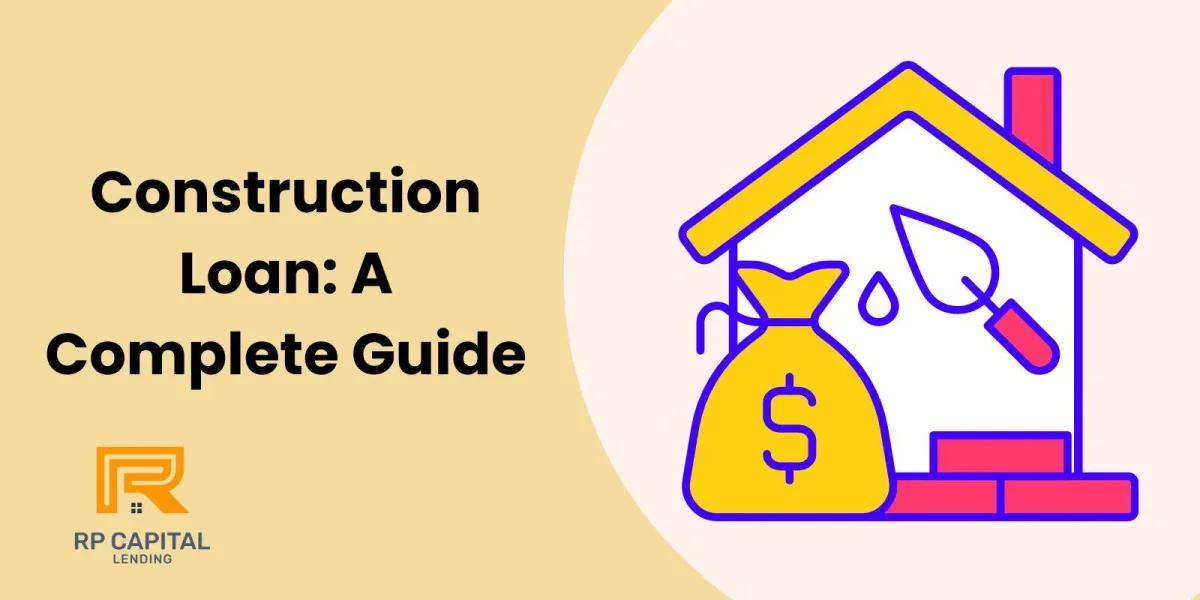Blog

Construction Loan Guide: Financing Your Dream Home Construction
Building your dream home or undertaking a significant renovation is an exciting venture, but it requires detailed planning and, more importantly, proper financing. Construction loans provide the financial foundation for such projects, allowing you to bring your vision to life.
This comprehensive guide will explore the essentials of construction loans, including their features, benefits, challenges, and application process. Let’s dive into the details to help you navigate this crucial financial tool.
What is a Construction Loan?

A construction loan is a short-term financing option that covers the costs of building a home, renovating an existing property, or even reconstructing a damaged structure. Unlike traditional mortgages, which are designed for completed properties, construction loans fund projects in progress. The disbursement of funds is tied to specific construction milestones, ensuring the money is used efficiently and only as needed.
How Construction Loans Work
Purpose-Specific: Funds are allocated solely for construction-related expenses, such as materials, labor, permits, and inspections.
Short-Term Duration: These loans typically last 6 months to 24 months, depending on the scope of the project.
Interest-Only Payments: Borrowers pay only the interest during the construction phase, reducing the financial burden until the project is complete.
Transition to Mortgage: Many construction loans convert into permanent mortgages once the building is complete, simplifying the financing process.
Example Scenario
Imagine you’re planning to build a custom home with an estimated cost of $400,000. A construction loan provides funding in stages, such as $50,000 for the foundation, $100,000 for framing, and so on. Once the project is complete, the loan transitions into a standard mortgage based on the home’s final value.
Features of Construction Loans

Construction loans are distinct from other financing options due to their structure and flexibility. Understanding their features is key to utilizing them effectively.
1. Incremental Disbursement
Funds are released in phases, known as "draws," as specific milestones are reached. For example:
Milestone 1: Site preparation and foundation laying.
Milestone 2: Framing and roofing.
Milestone 3: Electrical, plumbing, and interior work.
Lenders typically inspect the progress at each stage before releasing additional funds.
2. Higher Interest Rates
Construction loans generally have higher interest rates compared to traditional mortgages. This compensates lenders for the risks involved in financing a project that is not yet complete.
3. Tailored Terms
Borrowers can choose from various loan types, such as construction-to-permanent loans (which transition into mortgages) or standalone construction loans (requiring separate mortgage financing after completion).
4. Monitoring and Inspections
Lenders closely monitor the project through regular inspections to ensure that construction progresses as planned and funds are used appropriately.
5. Flexible Loan Amounts
The loan amount depends on the "after-completion value" of the property, which is the estimated worth of the home once construction is finished. Detailed plans and cost estimates are critical to securing the desired loan amount.
Pros and Cons of Construction Loans
Pros of Construction Loans
Customizable Financing
Construction loans are designed to meet the specific needs of your project, whether it’s building a home from scratch or undertaking a large-scale renovation.Controlled Disbursements
Incremental funding ensures money is allocated to the right stages, reducing the risk of overspending.Build Your Vision
Allows you to create a home tailored to your unique preferences, unlike buying a pre-built property.Streamlined Transition
Construction-to-permanent loans simplify financing by automatically converting into a traditional mortgage.
Cons of Construction Loans
Higher Costs
With higher interest rates and additional fees for inspections, construction loans can be more expensive than traditional mortgages.Stringent Requirements
Borrowers need excellent credit scores, detailed construction plans, and reputable contractors to qualify.Risk of Delays
Construction projects are prone to delays due to weather, labor shortages, or supply chain issues, which can increase costs.Complexity
The application and monitoring processes are more involved than those for traditional loans.
Types of Construction Loans
When planning a construction project, choosing the right type of loan is crucial. Here are the main types of construction loans:

1. Construction-to-Permanent Loan
Combines construction and mortgage financing into one loan, transitioning to a traditional mortgage after construction.
Best For: Homeowners who want a streamlined process.
Pros: Single closing, fixed interest rate for the mortgage phase.
Cons: Requires detailed upfront planning.
2. Stand-Alone Construction Loan
Covers only the construction phase, requiring a separate mortgage after completion.
Best For: Borrowers expecting better mortgage rates later.
Pros: Flexibility to shop for better mortgage terms.
Cons: Two sets of closing costs.
3. Owner-Builder Loan
For those acting as their own contractor to manage the construction project.
Best For: Experienced builders or homeowners with construction expertise.
Pros: Saves costs by eliminating contractor fees.
Cons: Requires significant construction knowledge.
4. Renovation Loan
Funds extensive renovations or rebuilds, typically using the home’s future value as collateral.
Best For: Homeowners upgrading or restoring properties.
Pros: Ideal for large-scale home improvements.
Cons: Requires detailed renovation plans.
5. End Loan
Traditional mortgages that finance a completed home, often used after construction.
Best For: Borrowers who need long-term financing for a finished property.
Pros: Lower interest rates compared to short-term loans.
Cons: Separate from the construction phase.
Challenges with Construction Loans
1. Unpredictable Costs
Material prices and labor costs can fluctuate due to market conditions. For instance, an increase in the cost of steel or wood can inflate your budget, leading to financial strain.
2. Construction Delays
Factors like bad weather, contractor availability, or permitting issues can slow down progress. Since funds are tied to milestones, delays can disrupt the flow of financing.
3. Stricter Lending Criteria
Lenders require borrowers to present detailed construction plans, cost breakdowns, and contractor agreements. Failure to provide these documents can lead to delays in loan approval.
4. Risk of Budget Overruns
Unforeseen challenges, such as site issues or design changes, can result in additional expenses. Borrowers must have a contingency fund to cover these unexpected costs.
Why to Choose a Construction Loan?
Construction loans are an excellent choice for individuals and families looking to build or renovate a home. Here’s why:
1. Freedom to Customize
Unlike purchasing a pre-built property, construction loans allow you to create a home tailored to your needs and preferences, from layout to finishes.
2. Financing Flexibility
Whether you’re building a primary residence, a vacation home, or an investment property, construction loans can be adapted to suit your goals.
3. Support for Large-Scale Renovations
For homeowners planning significant upgrades, construction loans provide the necessary funding to execute their vision.
4. Efficient Budget Management
The phased disbursement process ensures that funds are used for their intended purposes and helps keep the project on track.
Application Process for Construction Loans
Applying for a construction loan requires careful preparation and organization. Here’s a step-by-step breakdown:
1. Prepare a Comprehensive Plan
Provide detailed construction plans, including:
Blueprints or architectural designs.
Cost estimates for materials, labor, and permits.
A realistic project timeline.
2. Hire a Reputable Contractor
Lenders often require borrowers to work with licensed contractors who have proven experience. Be prepared to submit references, portfolios, and contractor agreements.
3. Submit Financial Documentation
Lenders will assess your creditworthiness based on:
Credit score (typically 680 or higher).
Proof of income (e.g., pay stubs, tax returns).
Debt-to-income ratio (ideally below 45%).
4. Loan Approval and Appraisal
Once your application is submitted, the lender will evaluate the project and may conduct an appraisal to estimate the property’s after-completion value.
5. Establish a Draw Schedule
Work with your lender to set up a draw schedule that aligns with your project’s milestones. This schedule determines when funds will be disbursed.
6. Monitoring and Inspections
Expect periodic site inspections to verify progress before additional funds are released.
Additional Tips for Construction Loans
Maintain a Strong Credit Score
Aim for a credit score of 680 or higher to increase your chances of approval and secure better loan terms.Save for a Larger Down Payment
Lenders typically require a down payment of 20–30% of the project’s estimated cost. A higher down payment can also reduce your interest rate.Work with Trusted Professionals
Partner with reputable architects, contractors, and project managers to ensure smooth execution.Create a Contingency Fund
Set aside 10–15% of your budget to cover unexpected expenses or delays.Compare Lenders
Shop around to find a lender offering competitive interest rates, favorable terms, and low fees.
5 FAQs About Construction Loans
1. What is the difference between a construction loan and a traditional mortgage?
A construction loan is short-term financing used to fund the building process, while a traditional mortgage provides long-term financing for completed properties.
2. Can I use a construction loan to build a vacation home?
Yes, construction loans can be used for primary residences, vacation homes, or even investment properties.
3. What happens if the project exceeds the budget?
You will need to arrange additional funding, either from personal savings or by applying for a separate loan.
4. Are construction loans available for owner-builders?
Yes, owner-builder loans are available, but lenders require the borrower to have significant construction experience.
5. Are interest rates fixed or variable?
Construction loans typically have variable interest rates, but some lenders may offer fixed-rate options.
Conclusion
Construction loans are a powerful financial tool for bringing your dream home or renovation project to life. While they come with higher interest rates and strict requirements, their benefits—such as customizable financing and phased disbursements—make them invaluable for large-scale projects. By understanding the features, application process, and potential challenges, you can make informed decisions and successfully complete your project.
Read More:
The Pros and Cons of Home Construction Loans for Remodeling
Maximizing ROI: How Construction Loans Fuel Profitable Real Estate Ventures
How to Calculate Cap Rate: Step-by-Step Guide with Examples & Formula
Pros and Cons of Taking Loans from Private Lenders: Key Insights & Real-Life Examples
Disclaimer: Loans only apply to non-owner occupied properties. Rates, terms and conditions offered only to qualified borrowers, may vary upon loan product, deal structure, other applicable considerations, and are subject to change at any time without notice.
Copyright © 2025. All Rights Reserved.


